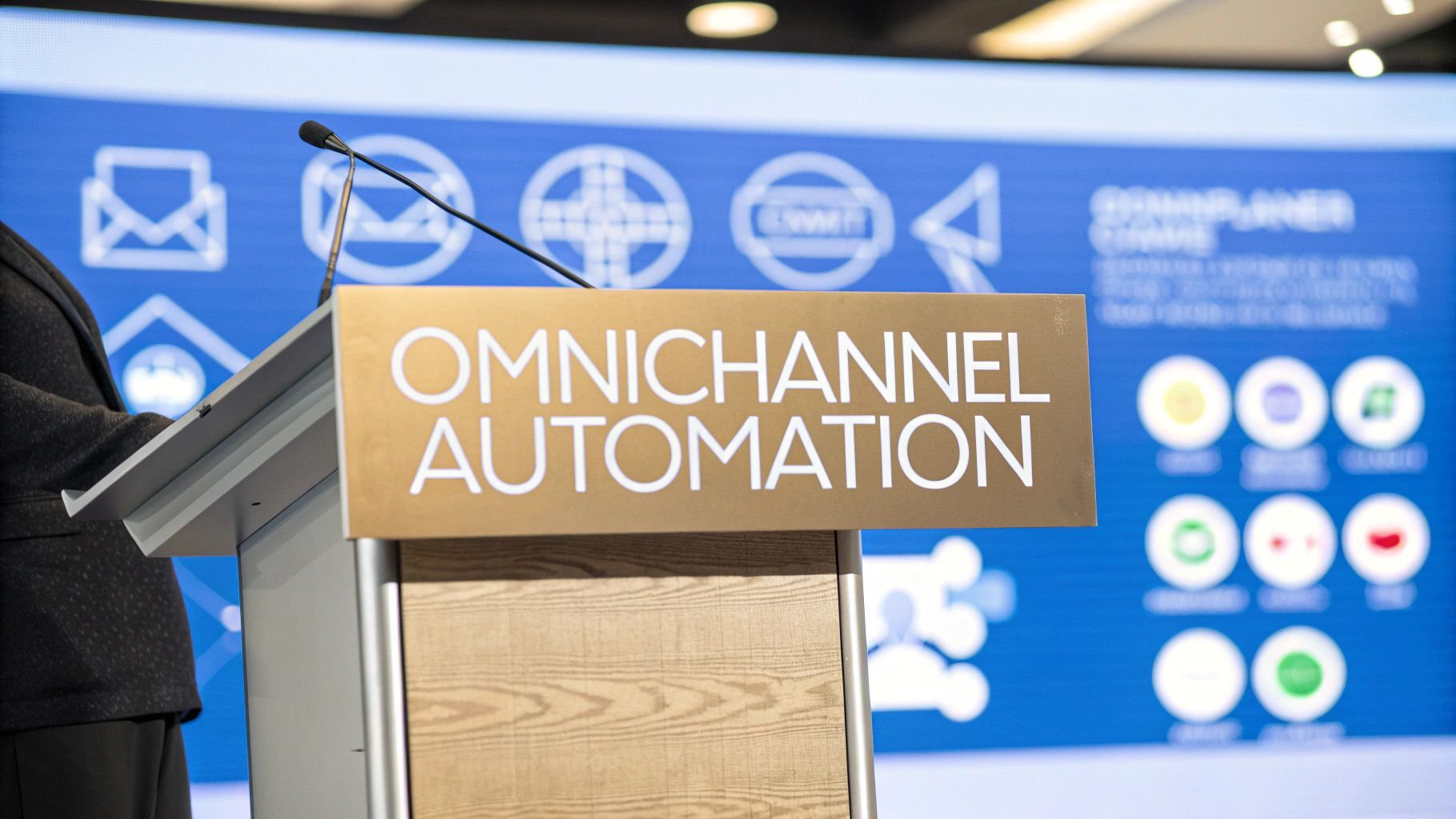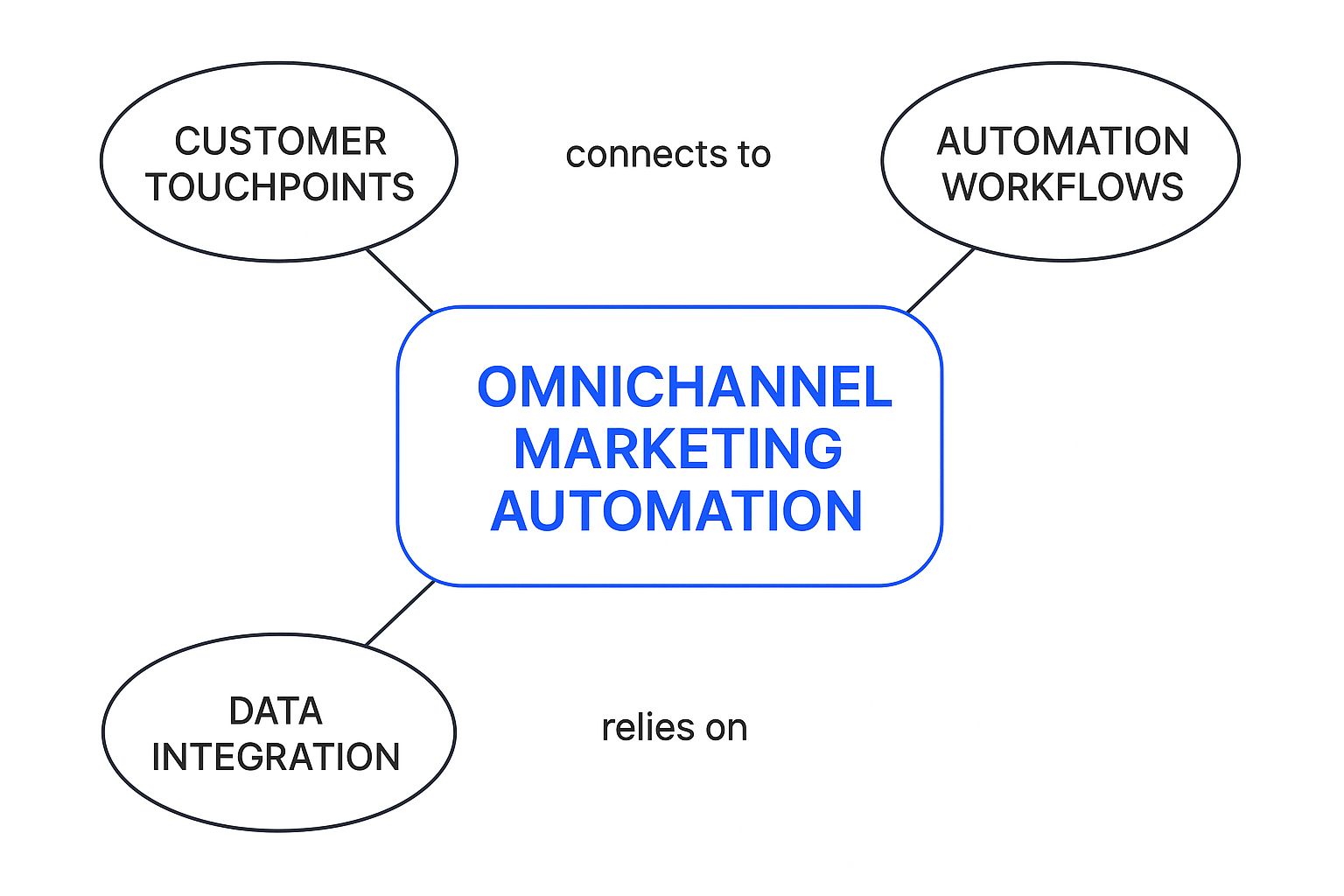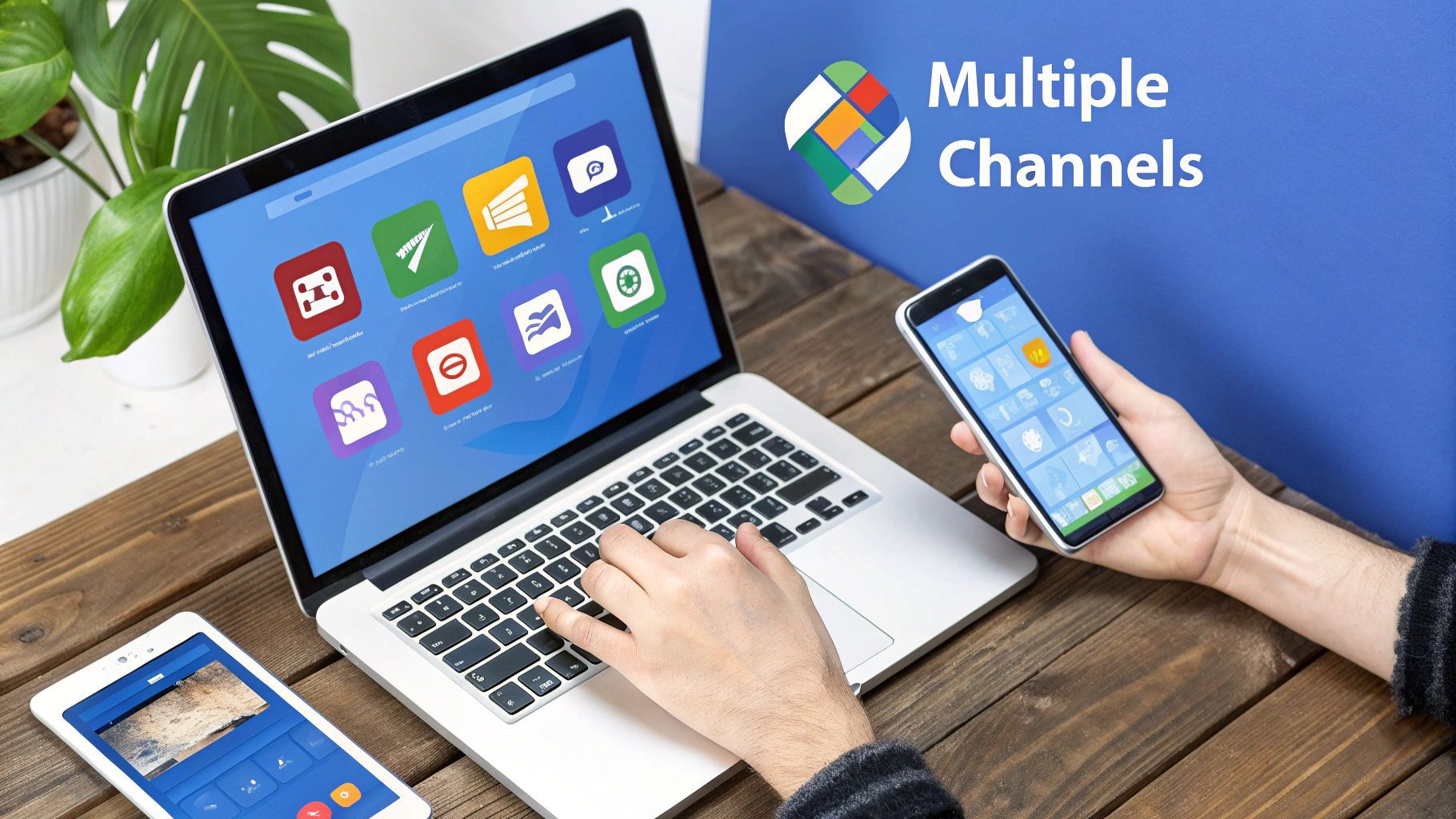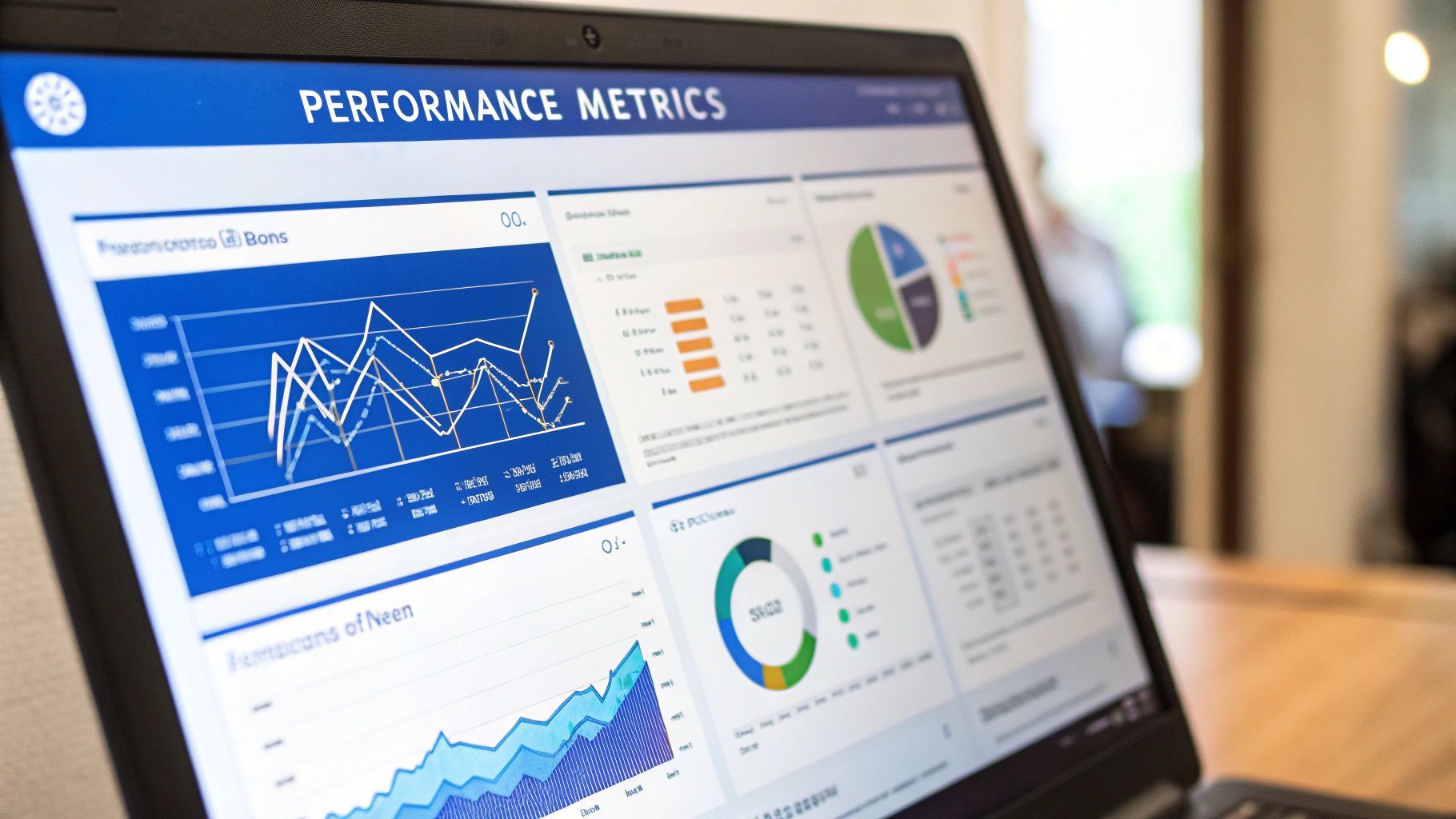
Guide to Omnichannel Marketing Automation
Discuss with AI
Get instant insights and ask questions about this topic with AI assistants.
💡 Pro tip: All options include context about this blog post. Feel free to modify the prompt to ask more specific questions!
Think of the best customer service you've ever had. Maybe it was a barista who remembered your exact coffee order or a personal shopper who knew your style inside and out. That’s the feeling omnichannel marketing automation aims to create, but at scale. It’s about using technology to build a single, intelligent conversation with each customer, no matter how or where they choose to interact with your brand.
Let's use an analogy. Imagine a world-class orchestra. The conductor's job isn't just to make sure every musician is playing their instrument; it's to ensure every sound blends together in perfect harmony to create a masterpiece.
In this scenario, the beautiful symphony is your customer's experience. The instruments are all your marketing channels: your email campaigns, social media posts, SMS alerts, in-store promotions, and website content.
Omnichannel marketing automation is the conductor. It coordinates every channel so they work together seamlessly. A customer might see a targeted ad on Instagram, click through to browse on your website, and later receive a timely SMS with a small discount to nudge them toward completing the purchase. The entire journey feels fluid, connected, and completely natural for the customer.
This connected approach is where many businesses get it wrong. They often mistake it for multichannel marketing. With multichannel, you have all the right instruments on stage, but they're all playing their own separate tunes. Your email team is focused on their campaigns, the social media team is doing their thing, and they rarely, if ever, sync up. This leads to a disjointed and sometimes confusing experience for the very person you're trying to impress: the customer.
An omnichannel strategy puts the customer at the absolute center of everything. It's built on the simple truth that a modern customer's path to purchase is rarely a straight line. They bounce between their phone, laptop, and even your physical storefront, and they rightfully expect your brand to provide a consistent experience across all of them.
This image perfectly illustrates the key pillars that hold up a truly connected customer experience.

As you can see, it’s not just about being present on multiple channels. Success comes from integrating customer data across every touchpoint and using smart automation to deliver the right message at the right time.
To truly grasp the difference, it helps to see the two approaches side-by-side. One focuses on the brand's channels, while the other revolves entirely around the customer's journey.
Attribute Multichannel Marketing (Separate Instruments) Omnichannel Marketing (Coordinated Symphony) Primary Focus Channel-centric. Each channel (email, social) operates independently to maximize its own performance. Customer-centric. All channels work together to create a single, unified experience for the customer. Data Integration Siloed. Data from one channel rarely informs the strategy of another. A "silo" mentality is common. Unified. A central customer profile collects data from all touchpoints, creating a 360-degree view. Customer Experience Fragmented. The customer experience can feel inconsistent and repetitive from one channel to the next. Seamless. The customer enjoys a continuous conversation with the brand, regardless of the channel they use. Goal Brand Presence. Being available on multiple platforms. Customer Loyalty. Building a cohesive journey that fosters deep, lasting relationships.
The table makes it clear: while multichannel marketing is about casting a wide net, omnichannel is about weaving that net into a strong, cohesive fabric that supports the entire customer journey.
Ultimately, the goal of omnichannel marketing automation is to deliver a superior omnichannel customer experience. This isn't just about making more sales in the short term; it's about earning genuine loyalty by consistently showing customers you understand their needs. The proof is in the numbers: marketers who successfully integrate three or more channels into a campaign see a staggering 494% higher order rate than those who stick to a single channel.
By bringing your data and communications under one roof, you can finally put an end to those classic marketing mishaps, such as:
- Sending a "Don't forget this item!" email for a product the customer already bought in-store.
- Showing ads for winter coats to someone in a tropical climate.
- Treating a long-time loyal customer like a stranger when they reach out for support on Twitter.
In the end, this strategy isn't about adding more channels for the sake of it. It’s about using your channels more intelligently to create one continuous conversation that makes every customer feel seen, heard, and valued.

To make a truly seamless omnichannel strategy work, you need a powerful engine running behind the scenes. This isn't about just buying a single piece of software; it's about understanding how several interconnected parts work together to gather data, make smart decisions, and deliver those personal touches automatically.
I like to think of it like a high-performance car. You don't just have an engine block. You also have a fuel system, an electrical system, and a transmission, and they all have to work in perfect harmony. In omnichannel marketing automation, the key components function in a similar, tightly integrated way.
Let’s pop the hood and look at the three critical systems that make it all go.
The bedrock of any intelligent automation is clean, unified customer data. This is where a Customer Data Platform (CDP) steps in. Think of the CDP as the central nervous system or the "single source of truth" for everything you know about your customers. It pulls in information from every single touchpoint—your website, mobile app, CRM, in-store sales, and social media channels—and stitches it all together into one complete profile for each person.
Without a CDP, your data is trapped in separate silos, which makes real personalization next to impossible. For instance, your email platform might have no idea that a customer just bought something from your Shopify store. A CDP demolishes those walls, making sure every part of your marketing machine is working with the same complete, up-to-the-minute information. This unified view is the high-octane fuel that makes meaningful automation possible.
Once you have all that unified data, the automation engine is what puts it to work. This component is the "if-this-then-that" brain of the operation, the part that actually builds out your customer journeys. It uses triggers and actions to create automated workflows that guide customers from one interaction to the next, almost like a GPS for their experience with your brand.
A journey builder lets you visually map out entire customer experiences. For example: IF a customer abandons their cart, THEN wait one hour and send a reminder email. IF they open the email but don’t click, THEN send an SMS with a small discount code 24 hours later.
This part of the engine goes way beyond simple, one-off campaigns. It allows you to create adaptive, multi-step conversations that react to customer behavior in real time. This ensures your brand is always delivering the next logical step in their journey, no matter which channel they happen to be on.
The last piece of the puzzle is the personalization engine. If the CDP provides the fuel and the automation engine maps the route, the personalization engine customizes the ride for each individual passenger. It taps into the rich data from the CDP to dynamically change content across every one of your channels.
This is what lets you do the cool stuff, like:
- Recommend products on your website based on what a user was just looking at.
- Address customers by name in emails, text messages, and even chatbot conversations.
- Show different promotional banners to first-time visitors compared to your loyal, returning customers.
This engine makes sure that every message feels like it was crafted specifically for the person receiving it. When you combine these three components—a unified data source, an intelligent journey builder, and a dynamic personalization tool—you get a powerful omnichannel marketing automation system that doesn't just sell products, but builds genuine customer relationships and drives real growth.

Putting an omnichannel strategy in place isn't just a fancy way to update your marketing playbook; it’s about creating real, measurable results for your business. The biggest win? A radically better customer experience, which has a direct line to higher retention rates and unshakable loyalty.
When you get rid of those clunky, disconnected moments that frustrate customers, you start building trust. Think about it: a customer buys a new pair of shoes in your store. A truly connected system—powered by omnichannel marketing automation—is smart enough not to blast them with ads for those same shoes online the very next day. Instead, it might send a helpful thank-you email with shoe care tips or suggest a matching accessory.
This kind of consistent, intelligent communication is what keeps customers happy and coming back. A smooth journey, no matter where they interact with you, makes people feel seen and valued. It’s no wonder brands with strong omnichannel strategies retain an average of 89% of their customers, a massive leap from the 33% retention rate for companies with weak omnichannel engagement.
By remembering a customer's preferences and past interactions, you stop making one-off sales and start building genuine relationships. This consistency makes your brand memorable, ensuring you’re the first one they think of when they’re ready to buy again.
The heart of omnichannel automation is making the customer's journey feel completely effortless. When you anticipate their needs with personalized interactions, you’re not just removing friction—you're building a foundation of loyalty that makes it incredibly hard for competitors to lure them away.
Having a single, unified view of each customer doesn't just prevent annoying mistakes; it unlocks new ways to grow revenue. When you understand someone's complete purchase history and browsing habits, you can offer relevant upsells and cross-sells that feel like genuine suggestions, not just a sales pitch.
- Smarter Recommendations: If a customer just bought a new camera, your automation can intelligently follow up with offers for lenses or a tripod, not another camera.
- Targeted Promotions: You can easily segment your highest-value customers and give them exclusive early access to sales or new product launches, making them feel like VIPs.
- Proactive Engagement: Channels like SMS and WhatsApp are perfect for more than just marketing. Using WhatsApp marketing automation, you can provide real-time order updates or answer quick questions, deepening that customer relationship even further.
This shift is more important than ever. The data is clear: 75% of consumers say they are more likely to buy from a brand that offers a personalized experience. And it pays off—brands that implement omnichannel marketing see revenue jump by 10-15% and engagement rates climb by 20-30%.
Finally, let’s talk about the "automation" in omnichannel marketing automation. By setting up automatic workflows for routine tasks—welcome emails, abandoned cart reminders, post-purchase follow-ups—you free up your team’s time and energy. Instead of getting bogged down in repetitive manual work, they can focus on the strategic and creative initiatives that truly move the needle.
This newfound efficiency allows your marketing team to orchestrate complex, multi-step campaigns across a dozen channels without needing to double their headcount. With centralized campaign management and analytics, you also get a much clearer picture of what’s working and what isn’t, helping you make faster, smarter decisions that boost your return on investment.
Theory is great, but seeing how this all plays out in practice is where it really starts to make sense. The real magic of omnichanel marketing automation happens when you watch it create smooth, intelligent journeys for customers. These aren't just isolated campaigns; they're ongoing conversations that react and adapt to what a person does, no matter where they interact with your brand.
Let's walk through a couple of real-world scenarios to see what this looks like.
Meet Sarah. Her journey starts on her phone while browsing a retail app for a new pair of running shoes. She finds a pair she likes, adds them to her cart, but then life happens—she gets distracted and closes the app.
This is where smart automation takes over:
- The Gentle Nudge: An hour later, an automated email appears in her inbox. It’s not a generic "You forgot something!" message. Instead, it shows her the exact shoes she was considering and offers a small, time-sensitive discount to sweeten the deal.
- The Helpful Tip: The next day, a push notification pops up from the app. It's not another sales pitch. It’s a link to a blog post titled, "5 Tips for Choosing the Right Running Shoe." This builds trust by offering genuine value and keeps the brand on her radar.
- The Local Alert: A few days later, Sarah is walking near one of the brand's physical stores. The app uses her location to trigger one last push notification: "The shoes you love are in stock here! Come try them on and get your discount."
This entire sequence guided Sarah from online browsing to an in-store visit without ever feeling aggressive or disjointed. Every message was a logical next step, creating one unified experience. It’s a world away from a siloed approach where she might have been bombarded with three completely unrelated ads.
The goal is to make the technology disappear. For the customer, it shouldn't feel like they're in an automated funnel. It should feel like a brand that truly gets them and is there to help every step of the way.
Now, let's look at a B2B example. A marketing manager named David registers for a webinar about lead generation. That one action sets off a carefully planned automated sequence designed to guide him from a curious attendee to a warm lead.
- Immediate Follow-Up: Right after the webinar ends, David gets a thank-you email. It includes a link to the recording and a PDF of the slides, providing instant value.
- The Human Connection: The automation system flags David as a high-intent lead and alerts a sales rep. That rep then sends David a personalized connection request on LinkedIn, mentioning a key takeaway from the webinar.
- Relevant Content: A week later, another automated email arrives, but this one contains a detailed case study specifically for David’s industry.
This automated workflow ensures that promising leads like David don't just go cold. It blends digital communication with a perfectly timed human touch. For more creative ideas, you can check out these other powerful omnichannel marketing examples and see how other brands are connecting their channels.
A truly effective omnichannel strategy weaves together a diverse set of channels—from email, SMS, and social media all the way to well-integrated direct mail services. Each channel has its own part to play, but they all work together to keep the customer's journey moving forward.
If you think of standard omnichannel automation as a skilled orchestra playing from a fixed sheet of music, then adding Artificial Intelligence is like giving the conductor the freedom to improvise. The AI doesn't just follow the notes; it listens to the audience's reaction and composes a new melody on the spot, perfectly matching the mood. This is the leap we're seeing—from simple, rule-based automation to intelligent, predictive orchestration that gets ahead of what customers want.
This shift is making every single customer interaction smarter. By 2025, the way AI is woven into omnichannel marketing automation will completely reshape how we engage with customers. The numbers tell a powerful story: the generative AI market is expected to grow from roughly $62.75 billion in 2025 to an incredible $356.05 billion by 2030. It’s no surprise, then, that 79% of marketers already say AI has made their teams more profitable.
One of the most exciting applications of AI is predictive analytics. AI algorithms sift through mountains of customer data—things like past purchases, browsing habits, and engagement levels—to predict what a customer will do next with stunning accuracy. This is where automation stops being just reactive and starts being proactive.
Think about it this way: an AI system could spot a high-value customer whose activity has recently dropped off, flagging them as a churn risk. Before a human ever notices, the system can automatically launch a personalized campaign with a special offer, crafted specifically to bring that customer back into the fold. It's about solving problems before they even become problems.
Generative AI is another massive breakthrough. It can produce high-quality, personalized content on a scale that marketing teams could only dream of before. Gone are the days of blasting the same generic email to everyone. Now, generative AI can write unique messages tailored to different customer segments.
- Customized Email Copy: It can generate subject lines and email content that directly reference a customer's recent activity or purchase.
- Dynamic Social Media Posts: It can adjust the tone and style of a social media post to feel native to the platform and speak directly to a specific audience.
- Smarter Chatbot Conversations: AI-powered chatbots can now manage complex customer questions with a surprisingly human touch, personalizing responses based on that user's history.
By taking over the heavy lifting of content creation, AI gives marketers their time back to focus on big-picture strategy and creativity. This enables a degree of hyper-personalization that makes every customer feel seen, a crucial element of effective lead generation. To learn more, take a look at our complete guide on automated lead generation.

It’s one thing to get your hands on a new platform, but it’s another thing entirely to build a winning strategy around it. The real secret to successful omnichannel marketing automation isn't just about the technology; it’s about having a clear, actionable roadmap from day one. To get there, you first need to understand how to create a seamless omnichannel experience from your customer's perspective.
Start by thinking strategically. Before you touch a single setting, take the time to map out your entire customer journey. Trace every step a customer might take, from the very first ad they encounter all the way to the post-purchase follow-up. This exercise is invaluable for spotting friction points and uncovering opportunities to make their experience smoother and more connected.
Don't try to boil the ocean. A common mistake is attempting to automate every single process right out of the gate. The most effective approach is to "crawl, walk, run." Start with a small, manageable project, prove it works, and then build from there.
Your next big task is to break down the data silos within your company. Right now, your customer information is probably spread across different systems—your CRM, your e-commerce site, and your email marketing tool. True omnichannel success depends on bringing all that data together into a single, unified profile for each customer. This is the foundation for sending messages that feel genuinely personal and relevant.
Once you’ve laid the groundwork, resist the urge to launch a massive, company-wide campaign. A much smarter move is to start with small, focused pilot campaigns. This lets you test your ideas and learn quickly without a lot of risk.
An iterative approach helps you:
- Test specific workflows: See how customers actually respond to a new abandoned cart sequence.
- Refine your messaging: A/B test different subject lines or offers on a limited audience.
- Gather real-world data: Use what you learn from these small tests to make your larger strategy even better.
Focusing on smart automation also delivers huge wins for your team. We’re seeing a convergence of sales and marketing automation, and companies using AI-powered tools are reporting ROI improvements of 10-20%. Even better, 90% of knowledge workers report that automation has improved their job satisfaction. By freeing up an average of five hours per week, it allows them to shift their focus to more strategic, high-value work. You can explore more about these sales automation statistics and trends to see the full picture.
When you start thinking about building your own omnichannel strategy, a few questions almost always pop up. Let's walk through them so you can move forward with confidence and sidestep some common early hurdles.
The most important first step has nothing to do with technology. It’s all about strategy. Start by mapping out your customer journey as it exists right now, from the very first touchpoint to the last.
This exercise will show you exactly where your customers interact with you, where the experience feels clunky, and what the ideal journey should look like. Once you have that map, and only then, should you start looking at software.
Bringing all your customer data together is a classic challenge, but it's one with a clear solution: a Customer Data Platform (CDP). Think of a CDP as your central hub. It's built specifically to collect information from all your different tools—your CRM, website analytics, social media accounts, you name it—and stitch it all together.
What you get is a single, clean profile for every customer. This unified view is the foundation for any real personalization and a non-negotiable for a true omnichannel approach.
A CDP is like a universal translator for your customer data. It makes sure every team and every tool is speaking the same language, which is absolutely essential for a cohesive omnichannel marketing automation strategy.
Yes, absolutely. You don't need a massive budget or a huge team to make this work. Many of the best automation platforms today are designed to scale, offering entry-level plans that are perfect for smaller businesses.
The trick is to start small and be strategic. Don't feel pressured to connect every single channel on day one. Instead, focus on integrating two or three of your most important channels first—maybe email and your website—and build from there as you grow.
Ready to bring all your customer conversations into one place and grow your business? Spur’s AI-powered platform makes it easy to automate marketing and support across all your channels. Start your free 7-day trial today at https://www.spurnow.com.
